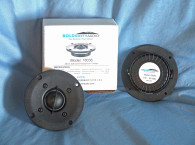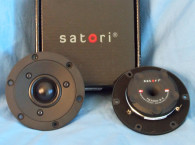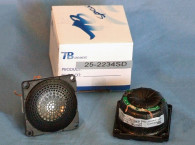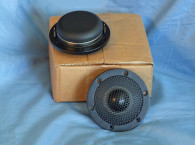
The ETON Hexacone sandwich cone, patented by ETON became known worldwide for its high degree of stiffness and its light weight. This results in a unique sonic timbre that is proprietary to ETON loudspeakers. ETON’s 29HD2 neodymium motor tweeter has, as you would expect, a fairly rich feature set that includes an aluminum faceplate, a 28 mm diameter magnesium diaphragm with a ceramic coating on both sides protected by a cosmetically attractive grill/phase plug, and driven by an aluminum former wound with round copper-clad aluminum wire (CCAW). Other features include an injection-molded surround, an underhung neodymium magnet motor design with a cast-aluminum cavity/heatsink, a 0.6 mm Xmax, and gold-plated terminals. There is no ferrofluid (magnetic fluids are great for lowering warranty replacement, but even very low viscosity magnetic fluids can cause audible damping to musical transients). Specs also state a 120 W power handling and a frequency range of 2 kHz to 20 kHz, suggesting a low crossover at 2 kHz—especially if you include a LCR (inductance, capacitance, and resistance)—conjugate in the
crossover design.





To begin, I used the LinearX LMS analyzer to produce the 300-point impedance sweep shown in Figure 1. The 29HD2’s impedance resonance occurs at 619 Hz (factory spec is 590 Hz at 1 W). With a 6.77 Ω DCR (factory spec is 6.80 Ω), with the minimum impedance for this tweeter measuring 7.28 Ω at 3.42 kHz. Next, I recess-mounted the ETON tweeter in an enclosure with a baffle area of 17” × 8” and measured the on- and off-axis frequency response with a 100-point gated sine wave sweep at 2.83 V/1 m. Figure 2 shows the on-axis response to be a flat ±2.6 dB from 2 kHz to 10 kHz, with the diaphragm breakup mode centered on 22 kHz.
Figure 3 gives the on- and off-axis response, with the off-axis curves normalized to the on-axis response shown in Figure 4, plus the CLIO 180° polar plot (measured in 10° increments) shown in Figure 5. Figure 6 shows the two-sample SPL comparison, indicating the two samples were closely matched to within 0.25 dB throughout most of its operating range, with some minor 1 dB variation at 2 kHz and 7.5 kHz. Next, I used the Listen SoundConnect analyzer along with the Listen SCM 0.25” microphone to measure the impulse response with the tweeter recess-mounted on the test baffle. Importing the windows impulse response into the Listen SoundMap software resulted in the CSD waterfall plot shown in Figure 7. The same data was used to produce the STFT displayed as a surface plot (see Figure 8).
For the last objective test, I used a noise stimulus to set the 1 m SPL to 94 dB (3.20 V) and measured the second (red curve) and third (green curve) harmonic distortion at 10 cm (see Figure 9). All the ETON drivers I have either reviewed or worked with over the years have exhibited outstanding performance and build quality and the ETON 29HD2 obviously delivers the same “je ne sais quoi.” For more information, visit www.eton-gmbh.com. VC











